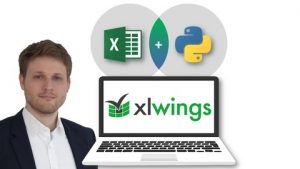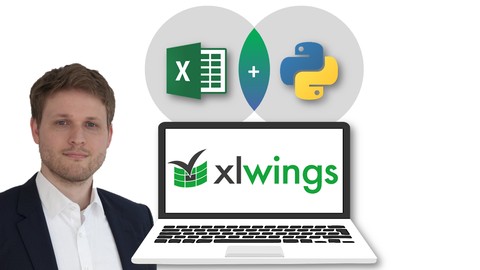Udemy – Python for Excel: Use xlwings for Data Science and Finance Course. Integrate Excel and Python and get the best of two Worlds! Python Beginners welcome. Use Pandas, Seaborn & co. in Excel
Python for Excel: Use xlwings for Data Science and Finance Course
Python for Excel: Use xlwings for Data Science and Finance is a Udemy course that teaches users how to automate Excel with Python code. The course covers topics such as:
- xlwings library: Learning the xlwings library from the ground up
- Graphical User Interface (GUI): Using Excel as a GUI and running Python code with it
- Dashboard apps: Creating dashboard apps with Excel (frontend) and Python (backend)
- Data visualization tools: Using data visualization tools like Matplotlib and Seaborn in Excel
- Python from scratch: Learning Python from scratch with a crash course
- UDFs: Writing user defined functions (UDFs)
- Numpy, Pandas, and Machine Learning Libraries: Using these libraries directly in Excel
- Excel tools: Writing Excel tools with Python instead of VBA
The course also teaches users how to use xlwings to automate Excel reports with Python, prototype web apps, and write and use dynamic arrays.
xlwings is a Python library that allows users to call Python from Excel and vice versa. It’s compatible with Excel as part of a Microsoft 365 subscription, as well as with one-time purchase versions like Office 2016 or Office 2021. xlwings is also open core and free, with xlwings PRO functionality available for free for non-commercial use.
To use Python in Excel, users can type “=PY(“ in their Excel cell, followed by their Python code. The results of the Python calculations or visualizations will then appear in the Excel worksheet. For example, users can use Python code to join two complex datasets, right within Excel.
What you’ll learn
- Automate Excel with clean and powerful Python Code
- Learn and master the xlwings library from 0 to 100
- Use Excel as Graphical User Interface (GUI) and run your Python code with Excel
- Create powerful Dashboard Apps with Excel (frontend) and Python (backend)
- Use powerful Data Visualization Tools (Matplotlib, Seaborn) in Excel
- Learn Python from scratch with a taylor-made Crash Course (For Python beginners)
- Write UDFs (user defined functions) and use Numpy, Pandas and Machine Learning Libraries directly in Excel
- Write Excel tools with Python instead of VBA and call your code directly from within Excel
- Use xlwings to automate Excel reports with Python
- Prototype Web apps
- Write and use Dynamic Arrays with xlwings
- Run your financial model 10,000 times & more with a Python Monte Carlo Simulation
- Load (financial) data from Web APIs directly into Excel
- Run Python Scripts from within Excel with Run main and RunPython
- Replace VBA macros with clean and powerful Python code
Other courses related to Python for Excel
R Programming A-Z™: R For Data Science With Real Exercises! Best seller
100 Days of Code: The Complete Python Pro Bootcamp Best seller
Python A-Z™: Python For Data Science With Real Exercises!
ChatGPT for Python Data Science and Machine Learning Featured
Who this course is for:
- Data Scientist and Finance Professionals seeking to use Excel as Frontend and Python as analytical Backend in their Projects.
- Excel professionals seeking to write Excel tools with clean Python code instead of VBA/Marcos.
- Python Beginners are welcome as the course includes a Python Crash Course designed for Excel Professionals.
- Python Developers seeking to work with Excel as GUI (Graphical User Interface).
Course Information for Python for Excel
- Publisher : Udemy
- Instructor : Alexander Hagmann
- Language : English
- Level of training : from beginners to advanced
- Duration Time : 17 hours
Python for Excel: Use xlwings for Data Science and Finance

Integrate Excel and Python and get the best of two Worlds! Python Beginners welcome. Use Pandas, Seaborn & co. in Excel
Product Brand: Udemy
4.4
Pros
- Automation: Python can automate a lot of work.
- Data connectivity: Python can connect to cloud-based data.
- Flexibility: Python is highly flexible and customizable.
- Data importing and manipulation: Python can read any type of data, including structured and unstructured data.
- Security features: Python code in Excel runs on the Microsoft Cloud, providing enterprise-level security.
- Team collaboration: It's easier to share workbooks that contain Python code.
Cons
- Learning curve: Python has a steeper learning curve than Excel.
- Programming skills: Python requires programming skills and knowledge of Python language and libraries.
- Real-time data analysis: Python in Excel doesn't natively support real-time data analysis.









